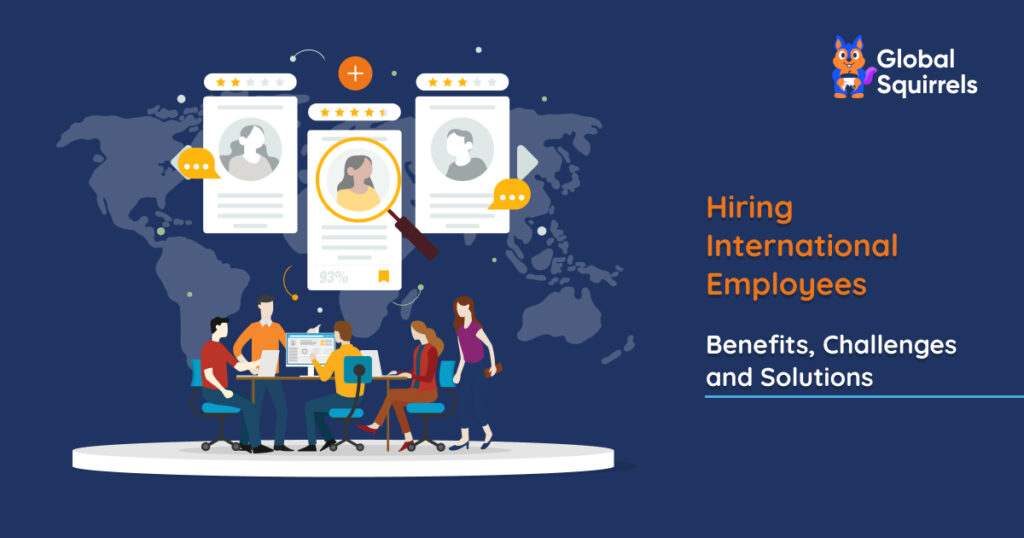Hiring international remote employees – benefits, challenges, and solutions

With the increasing connectivity of the world, businesses have started to expand their operations globally. Hiring international remote employees offers a wealth of benefits, from accessing specialized skills to fostering innovation. While presenting challenges, such as legal compliance, however, it is also a unique problem.
In this blog, we will delve into the advantages and drawbacks of hiring international remote employees, explore some of the top countries to consider for recruitment, and provide insights into how Global Squirrels can help you navigate the complexities of hiring global employees.
Benefits of hiring international employees
Hiring international employees remotely offers numerous advantages that can significantly enhance a company’s operations and workforce diversity.
A broader talent pool
One of the key benefits of hiring international employees is access to a larger and more diverse talent pool. By hiring employees globally, you can recruit highly skilled professionals who may not be available locally. It enables teams to be diverse as it fosters innovation and creativity, thereby bringing different perspectives and experiences into problem-solving and collaboration.
Cost savings
An enormous cost savings opportunity is associated with hiring a global workforce. This is because of a lower cost of living. Many countries have much lower payroll expenses than you will find in the U.S. which could potentially be most suitable for startups and small businesses that aim to optimize budgets, as this makes hiring international employees especially advantageous. Additionally, hiring employees globally eliminates relocation expenses and the need for physical office spaces, further reducing costs.
Increased productivity
Another benefit of hiring international employees is that productivity increases. Studies suggest that remote employees, a staple of global hiring, are often more productive because of fewer workplace distractions and the comfort of their homes. In addition, a global workforce that serves your customers and projects around the world provides a 24/7 work cycle, which allows for continuous project progress and faster turnaround times.
Enhanced global presence
Hiring a global workforce enhances a company’s global presence and brand reputation. A diverse and inclusive team is not just a good idea for your clients but also a way to attract top talent from across the world. This commitment to inclusivity and global engagement positions your business as forward-thinking and adaptable in an increasingly interconnected world.
Challenges of hiring international employees
Setting up an entity
To hire international employees, businesses sometimes need to establish a local entity in the country where they want to recruit employees. This is because of all the legal requirements that come along, such as registration, taxation, and compliance with local labor laws. This process can be costly and time-consuming. If companies decide to set up a subsidiary or branch office, they can incur high costs such as legal fees, office space, and administrative overheads.
Non-compliance
When you hire international workforce, there are more to consider than traditional labor laws, taxes, and immigration requirements. There are laws for employment contracts and taxation in each country. Severe penalties in the form of fines and restrictions on business operations can follow non-compliance.
Workforce management
Managing a global workforce involves balancing the benefits of hiring international employees with the challenges of hiring international employees. Adapting to country-specific timesheets, payroll cycles, and leave policies is essential when hiring employees globally in regions like India, the Philippines, and Mexico. While hiring global employees provides access to a diverse talent pool and fosters innovation, it also requires precise job matching and efficient task management to maintain productivity. The hiring international workforce process can be complex, especially when addressing compliance issues and streamlining tasks like pay adjustments or terminations.
RELATED READ: International Payroll Management – Challenges and Solutions
How can Global Squirrels help you in hiring global employees?
Global Squirrels is a Software as a Service (SaaS) staffing and payrolling platform that allows your business to hire employees globally who meet all your business requirements effortlessly. Our platform also helps you manage these employees by offering administrative functions such as payroll & benefits management, performance management, task and timesheet management, and compliance with local and international labor and tax laws.
Here is how Global Squirrels solves all your hiring challenges.
- Once you partner with our platform, there is no need to set up an entity in the country you want to hire. This is done with the help of our Employer of Record (EOR) where our platform acts as your legal entity. This not only saves you time but also operations and hiring costs.
- Global Squirrels ensures complete compliance with local and international laws by prioritizing employment and tax laws and continuously updating itself with the most recent ones.
- Our platform offers country-specific timesheets and leave management features to guarantee compliance with local regulations. With AI features for optimizing hiring, matching skills to jobs, auto-generating offer letters, and a task assignment tool for remote teams, the platform helps keep everyone organized. Finally, our user-friendly portal makes it easy for pay adjustments and terminations without the burden of administrative tasks. Using these tools, businesses can easily manage their global workforce in terms of compliance, productivity, and employee satisfaction.
Let us now talk about our two most popular hiring plans:
Purple Plan
With our Purple Plan, you can convert and onboard a freelancer or an already-sourced professional from any country. Our platform once the onboarding process begins, HR-related tasks, including the onboarding process, offer letter generation, compliance with local labor laws, and payroll & benefits management, are handled by our platform. With this streamlined approach, you get a hassle-free experience to hire global employees without any administrative complexities.
Orange Plan
The Orange Plan finds and hires top talent who meet your job requirements. Our platform will pre-screen candidate profiles, perform background checks, and share the top curated profiles with you within 2 to 5 business days on the Global Squirrels platform. After you have shortlisted candidates, we will set up interviews, and our platform will proceed with the seamless onboarding of your selected candidates.
Are you ready to hire international employees effortlessly? Request a demo today!
